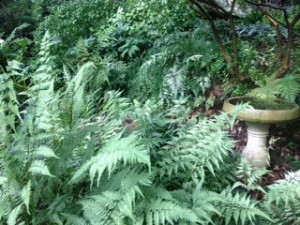 With 2013 beginning with a wet, cool spring and the rain continuing into early summer, it seemed like we’d been transported into a different universe than Alabama, didn’t it? All the rain may have caused some complacency – everything seems so much lusher than it usually is this time of year…now the heat is here, though, and it seems certain we’ll be entering our usual summer pattern of hit and miss rain showers with lots of warmth and humidity…
With 2013 beginning with a wet, cool spring and the rain continuing into early summer, it seemed like we’d been transported into a different universe than Alabama, didn’t it? All the rain may have caused some complacency – everything seems so much lusher than it usually is this time of year…now the heat is here, though, and it seems certain we’ll be entering our usual summer pattern of hit and miss rain showers with lots of warmth and humidity…
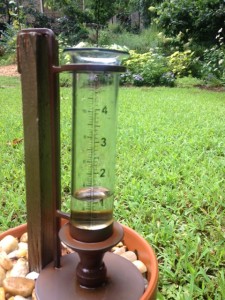 Established plantings in your landscape should be doing well, but be aware that new plantings of shrubs, trees and perennials will need supplemental watering this first summer – pay attention to them. The requirement for new plantings is an inch of water each week.
Established plantings in your landscape should be doing well, but be aware that new plantings of shrubs, trees and perennials will need supplemental watering this first summer – pay attention to them. The requirement for new plantings is an inch of water each week.
It’s also a good idea to group plants together that need the same amounts of moisture. For example, you wouldn’t want to place a water loving Japanese Iris in the same bed as sedums…one will surely die from too much, while the other may not receive enough. Either way, it’s not a good scenario!
When you determine that new plantings or even established ones in your landscape need water, remember that the early morning hours are the best time. If you have an irrigation system, schedule it to run between 4 a.m and 7 a.m. or handwater as early in the day as you can.
All gardeners should be aware of conserving water, and an easy way to save water and money, if you have an irrigation system, is to install a water sensor. It will detect when the landscape is receiving moisture and will shut off your system, so you’re not one of those watering your lawn when it’s raining! It’s one of those easy fixes everyone with an irrigation system should be aware of.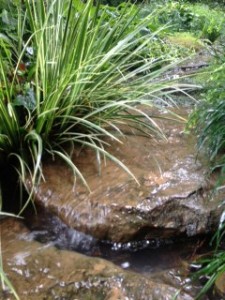
If you handwater using a hose, direct the water onto the soil, not over the foliage of the plant. The goal is to water deeply but infrequently, so the roots of your plants travel down into the soil looking for moisture. Too many short watering cycles will create shallow root systems that are less able to withstand dry periods.
A very good resource for irrigation and other landscape information is available at http://www.aces.edu/pubs/docs/A/ANR-1359/index2.tmpl, the Alabama Cooperative Extension System’s Manual on Alabama Smart Yards, authored by Dr. Ken Tilt of Auburn.

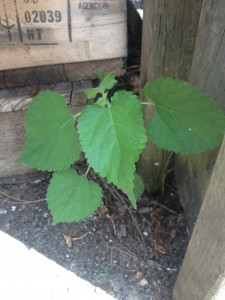 Mulberry weed, Fatuoua villosa, is a weed you definitely want to get rid of if you ever see it in your flower beds or any part of your landscape. Another common name is hairy crab weed – that doesn’t sound very pleasant does it? I cuss this weed out every time I see one (or more) in my garden…the main problem with this noxious weed is that it spreads by seed…and the seeds occur on very tiny plants. In my research, I keep finding that maintaining a 2″-4″ layer of mulch will help smother germinating seeds, and that pre and post emergent herbicides are very effective. Hower, because it grows so closely among desirable plants, using herbicides can be problematic, and not my favorite solution anyway.
Mulberry weed, Fatuoua villosa, is a weed you definitely want to get rid of if you ever see it in your flower beds or any part of your landscape. Another common name is hairy crab weed – that doesn’t sound very pleasant does it? I cuss this weed out every time I see one (or more) in my garden…the main problem with this noxious weed is that it spreads by seed…and the seeds occur on very tiny plants. In my research, I keep finding that maintaining a 2″-4″ layer of mulch will help smother germinating seeds, and that pre and post emergent herbicides are very effective. Hower, because it grows so closely among desirable plants, using herbicides can be problematic, and not my favorite solution anyway.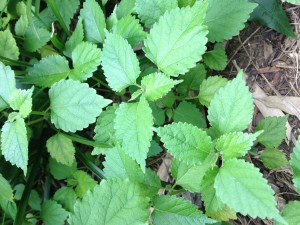
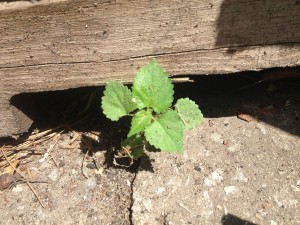 Listed as a noxious and invasive weed, it gets it’s common name because it looks similar to mulberry tree seedlings when they’re 4″ tall…but this herbaceous weed has a taproot and can grow 3′-4′ tall. You never, ever want them to get to that point though!!!! It has purplish green flowers with no petals, and the seeds, which appear on it when it’s not even 2″ tall, are explosively discharged up to 4′ from the original plant. Because of this, there is never just one of this weed, but more likely, colonies of it. It’s easy to pull when young, but because it develops a taproot, it becomes more difficult to pull as the plant gets larger. Be vigilant in eradicating this weed, and dispose of any that you hand pull into a trash bag immediately – don’t ever put it in your compost pile.
Listed as a noxious and invasive weed, it gets it’s common name because it looks similar to mulberry tree seedlings when they’re 4″ tall…but this herbaceous weed has a taproot and can grow 3′-4′ tall. You never, ever want them to get to that point though!!!! It has purplish green flowers with no petals, and the seeds, which appear on it when it’s not even 2″ tall, are explosively discharged up to 4′ from the original plant. Because of this, there is never just one of this weed, but more likely, colonies of it. It’s easy to pull when young, but because it develops a taproot, it becomes more difficult to pull as the plant gets larger. Be vigilant in eradicating this weed, and dispose of any that you hand pull into a trash bag immediately – don’t ever put it in your compost pile.